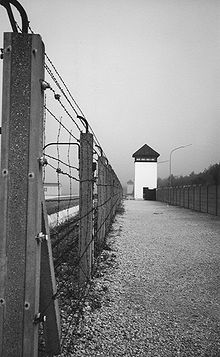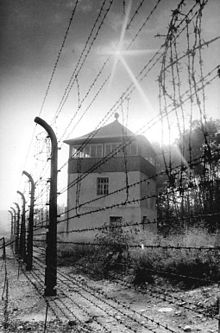Post obligation



The duty to post was the instructions to concentration camp guards on the use of their service weapon. The SS men had been ordered to "shoot sharply" immediately if they attempted to escape or if there was a threat from prisoners without warning. Warning blank firing was also prohibited.
In later Nazi trials, SS men invoked an alleged imperative to command . Defendants countered the accusation of the arbitrary, mass murder of prisoners that they had not murdered but acted in self-defense, or that prisoners were "shot while trying to escape", as prescribed in the service instructions.
Creation of the "post obligation"
First murders in Dachau concentration camp
On April 12, 1933, the Jewish prisoners Rudolf Benario , Ernst Goldmann and Arthur Kahn were shot after severe abuse in the Dachau concentration camp , which was the first of the National Socialist concentration camps to be set up on March 22, 1933 when the Nazis came to power .
Although Hitler and the NSDAP were already in power, their sphere of activity was far from being consolidated: On June 1, 1933, the Munich public prosecutor's office brought charges against Hilmar Wäckerle , camp commandant of the Dachau concentration camp , of facilitating murder.
New regulation
Himmler then deposed Wäckerle, the murders could hardly be covered up. Himmler had to present the death penalty in the Dachau concentration camp as legal. He did not want to expose his SS men to conviction by the public prosecutor. He commissioned Theodor Eicke to develop special camp regulations and appropriate service regulations.
Eicke therefore wrote the mandatory post with the instruction to shoot escaping prisoners immediately and without warning: “If a prisoner tries to escape, he must be shot without a call. The guard who shot an escaping prisoner in the course of his duties goes unpunished. ”As sanctions for the concentration camp staff, he stipulated immediate termination or imprisonment:“ If a guard is physically attacked by a prisoner, then the attack is not break with physical force but with the use of firearms. A post who does not observe this regulation has to wait to be dismissed without notice. "
Eicke dated his regulations for escorts and prisoner guarding on October 1, 1933. On the same day he wrote the notorious catalog of punishments . The catalog of punishments made minimal offenses a punishable offense. Posting allowed executions.
From 1937, further SS concentration camps were established. The service regulations from the Dachau concentration camp were adopted. Reich Justice Minister Franz Gürtner was in contact with Himmler in order to ease the post obligation somewhat, which led to insignificant results.
Perpetrator
The duty to post applied, for example, to the SS skull and crossbones associations . Towards the end of the war, men without SS membership were also used as concentration camp guards. Women were also employed in the concentration camps. For concentration camp guards was also the instruction and permission to exercise without warning from their firearm.
Death strip
Each prisoner area in a concentration camp was delimited by electrically charged fences, mostly walls. There was often a ditch in front of the wall. This was where the neutral zone was located, later also called the death strip by inmates , which they were not allowed to enter. SS men guarded this zone from watchtowers.
Node chains
Inmate work assignments outside a camp called the SS -camps . The SS guards formed so-called chains of posts at external commands in order to surround and guard the work site. The prisoners were not allowed to cross the imaginary line between the individual posts. If this happened, it was counted as an attempt to escape. There was immediate sharp fire without warning.
"Negligent Release" and Sanctions
Theoretically, after a successful escape from the prisoners, an SS man could be charged with negligent release of prisoners . Camp commandant Karl Koch in the Majdanek extermination camp was investigated internally because around 80 Soviet prisoners of war escaped during his service in July 1942. The case is closed. It only had the consequence of a punishment transfer.
Nazi trials in the post-war years
In 2015, the Lüneburg Auschwitz trial was about complicity in murder in 300,000 legally coinciding cases. The SS man Oskar Gröning was officially only an accountant in Auschwitz . No direct involvement in the murder could be proven. The Lüneburg district court assessed the threat from the SS in the camps, which was intensified by the sharp use of firearms, as a contribution to the smooth operation of the industrialized Auschwitz killing factory . Groening had reported about his service weapon and said that he was involved when the SS was looking for a prisoner who had fled. He was demonstrably involved in the killing machine.
War crimes within the scope of compulsory posting
Posting was part of many end- stage crimes , for example
- Mühlviertel Hare Hunt (February 1945)
- Celle massacre (April 1945)
literature
- Lothar Gruchmann : Justice in the Third Reich 1933–1940. Adaptation and submission in the Gürtner era .
- Stanislav Zámečník : (Ed. Comité International de Dachau): That was Dachau. Luxembourg, 2002.
Web links
- Article by Frank Bajohr : Newer Holocaust perpetrator research, in: Docupedia-Zeitgeschichte, June 18, 2013
Individual evidence
- ↑ Letter of June 2, 1933, Public Prosecutor's Office, Regional Court Munich II, to the State Ministry of Justice: Subject: "Death of prisoners in protective custody in the Dachau concentration camp." Prisoners: Castle, Hausmann, Strauss and Nefzger. - from: Zámečník: That was Dachau.
- ^ Zámečník: That was Dachau. P. 40.
- ^ Judgment of the Lüneburg Regional Court against Oskar Gröning, July 15, 2015


